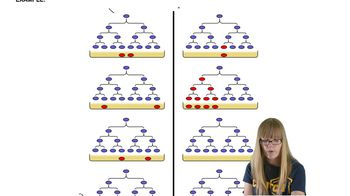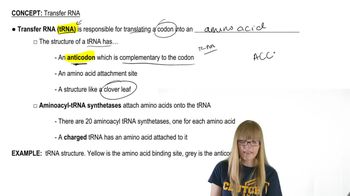Predict the amino acid sequence produced during translation by the following short hypothetical mRNA sequences (note that the second sequence was formed from the first by a deletion of only one nucleotide):
Sequence 1: 5'-AUGCCGGAUUAUAGUUGA-3'
Sequence 2: 5'-AUGCCGGAUUAAGUUGA-3'
What type of mutation gave rise to sequence 2?
Ch. 14 - Translation and Proteins
Chapter 14, Problem 13
A short RNA molecule was isolated that demonstrated a hyperchromic shift (see Chapter 10), indicating secondary structure. Its sequence was determined to be
5'-AGGCGCCGACUCUACU-3'
If the molecule were a tRNA fragment containing a CGA anticodon, what would the corresponding codon be?
 Verified step by step guidance
Verified step by step guidance1
Identify the anticodon sequence given in the problem: CGA.
Recall that anticodons are complementary to codons on mRNA, and they pair with mRNA during translation.
Determine the complementary bases for each nucleotide in the anticodon: C pairs with G, G pairs with C, and A pairs with U.
Write the complementary sequence for the anticodon CGA, which will be the codon on the mRNA.
The resulting sequence is the codon that corresponds to the given anticodon.

Verified Solution
Video duration:
1mWas this helpful?
Key Concepts
Here are the essential concepts you must grasp in order to answer the question correctly.
tRNA and Anticodon-Codon Pairing
Transfer RNA (tRNA) is a type of RNA that helps decode a messenger RNA (mRNA) sequence into a protein. Each tRNA molecule has an anticodon, a set of three nucleotides that pairs with a complementary codon on the mRNA. In this case, the CGA anticodon would pair with the corresponding codon on the mRNA, which is determined by the base pairing rules (A-U and C-G).
Recommended video:
Codon Structure
A codon is a sequence of three nucleotides in mRNA that specifies a particular amino acid or signals the termination of protein synthesis. The genetic code is universal, meaning that the same codons correspond to the same amino acids across different organisms. Understanding the codon structure is essential for translating the genetic information carried by mRNA into functional proteins.
Recommended video:
Guided course

Ribosome Structure
Hyperchromic Shift
A hyperchromic shift refers to an increase in the absorbance of UV light by nucleic acids, often indicating a change in their secondary structure, such as denaturation or the formation of new structures. In the context of RNA, this shift can provide insights into the molecule's folding and stability, which are crucial for its function in protein synthesis and other cellular processes.
Recommended video:
Guided course

Spontaneous Mutations
Related Practice
Textbook Question
366
views
Textbook Question
Discuss the potential difficulties of designing a diet to alleviate the symptoms of phenylketonuria.
212
views
Textbook Question
A short RNA molecule was isolated that demonstrated a hyperchromic shift (see Chapter 10), indicating secondary structure. Its sequence was determined to be
5'-AGGCGCCGACUCUACU-3'
If the molecule were an internal part of a message, what amino acid sequence would result from it following translation? (Refer to the code chart in Figure 13.7.)
281
views
Textbook Question
Individuals with phenylketonuria cannot convert phenylalanine to tyrosine. Why don't these individuals exhibit a deficiency of tyrosine?
512
views
Textbook Question
Early detection and adherence to a strict dietary regimen have prevented much of the intellectual disability that used to occur in those with phenylketonuria (PKU). Affected individuals now often lead normal lives and have families. For various reasons, such individuals tend to adhere less rigorously to their diet as they get older. Predict the effect that mothers with PKU who neglect their diets might have on newborns.
251
views
Textbook Question
Refer to Figure 13.7 to respond to the following:
Shown here is a hypothetical viral mRNA sequence:
5'-AUGCAUACCUAUGAGACCCUUGGA-3'
Assuming that it could arise from overlapping genes, how many different polypeptide sequences can be produced? What are the sequences?
319
views

